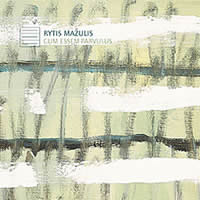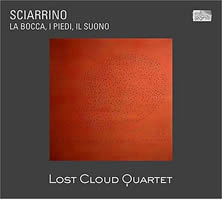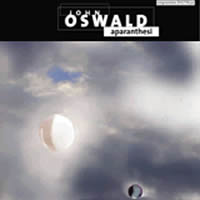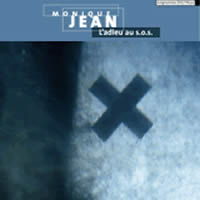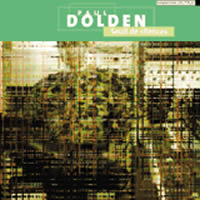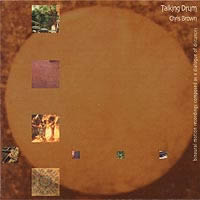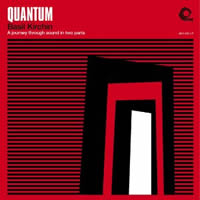Dipping into the “EA” Bucket 2.
|
Grant Chu Covell [March 2005.] I’ve delayed addressing a stack of electroacoustic discs. Despite being a sometime practitioner, finding the right words can be murderous: “Sounds like rain falling on an exit sign.” “Recalls grandma’s aromatic ginger cookies.” Often it’s better to say nothing. Similarly, technical explications do little for those who’ve never wrestled tape into a splicing block during pre-dawn studio time. Against the odds, then, comments about a smattering of recent releases follow. I’ll try to be lucid. The first three spill out of the ea bucket.
Cum essem parvulus. Rytis MAZULIS: Canon Solus (1998); Sybilla (1996); Cum essem parvulus (2001); ajapajapam (2002). Latvian Radio Chamber Singers; Chordos Quartet. Megadisc MDC 7810 (http://www.megadisc.be/). But this is choral music! Nevertheless, these four works reflect an electronic-music sensibility, and several require click tracks and tuners via headphones for their realization. Mazulis stands at an intersection of traditions and composers: minimalism, Renaissance polyphony, Ligeti, Radulescu, Scelsi and Nancarrow. Take note of this Lithuanian. The under-seven-minute Sybilla beguiles. The booklet lists five singers, but we hear more. Notes indicate the work is for mixed chorus of 12 voices, yet a miniaturized score sample shows 24 lines. A brief stanza from Petronius’ Satyricon is set to a shimmying microtonal palindromic canon which gradually mutates, widening in intervallic range before retreating. Canon Solus and Cum essem parvulus call for eight voices each. Canon Solus introduces the singers in pairs, altering rhythm and line lengths as their tune undulates. Cum essem parvulus gradually modulates each part’s rhythms and pitches in slow-moving glissandi. The first time through, I had to listen to each twice. The 35:49 ajapajapam put me back on Memory Lane: I recalled my mixed emotions upon hearing Andriessen’s De Staat for the first time. Mixed chorus, string quartet and electronics fuse into a fast-moving waterfall’s face. An individual voice or a string sound may peep through, but the abrasive yet invigorating composite texture makes discerning individual voices practically impossible. Progress appears slow as the clustered ranges widen and diminish. Like any good minimalism, the details will draw you in. The Latvian Radio Chamber Singers’ pitch and nuance are impeccable. They probably could have done without Mazulis’ cues or electronic guides. The recording venue and engineering are likewise superb. Definitely one of the year’s best.
Mad Sweeney’s Shadow. Frank CORCORAN: Quasi una Missa (1999); Piano Trio (1978); Balthazar’s Dream (1980); Rosenstock Lieder (1980); Third Wind Quintet, “Sweeney’s Wind-Cries” (1999); Sweeney’s Farewell, “Sweeney’s Last Poem” (1998). Hesketh Trio; Hamburg Trio, Sabine Sommerfeld (sop.); Daedalus Quintet. col legno WWE 1CD 20214 (http://www.col-legno.de/). Corcoran’s appearance on these pages has been wanting. Three of these six works are electroacoustic, so here’s my chance to fold him in. Welcome to an Ireland of myth and reality in equal parts, a “polyphony of history, not ideology or programme.” While other composers bend in the wind to find their voice, Corcoran unapologetically makes his mark with passionate stuff. But who is Sweeney? According to legend, Mad Sweeney was a seventh-century Irish king. At the battle of Moira (637 A.D.) he went crazy, and lived out his days as a “naked bird-man,” fleeing from people and hiding in trees. “Sweeney made art out of his suffering life, nature-lyrics of great beauty and cultures clash; artist and society are bipolar opposites.” Sweeney’s tale has spurred many Corcoran compositions. This disc wraps up with two. In four movements, the Quasi una Missa weaves Latin with old Irish myths and beliefs. Liberated from their museum cases, ancient bell, drums and trumpets coarsely punctuate precisely articulated Irish, English and Latin. The cautionary Kyrie leads to an incantational Gloria over water, then a snappy, cheery Sanctus. Folk tunes rumble through the closing Agnus Dei. Corcoran’s ritual is harsh medicine. He jokes that this piece is meant to get back at Cage for his touristy Roaratorio (Wergo WER 6922 2). A Borges story which supposes that culture is born from ritual killing inspired the pre-digital Balthazar’s Dream. Sweeney’s Farewell, “Sweeney’s Last Poem,” is a five-minute blip about the ultimate departure without panegyrics. Not knowing its title, you’d think it was someone else’s incoherent dream shuffling past. The Third Wind Quintet is as raucous and strident as a caged fury. Restless winds climb the horn’s naturally tuned scales. The Piano Trio’s players proceed along their own routes. Why the Brahms quote? Because its pitches have already plowed past disinterestedly. Another piano trio supports the singer in the Rosenstock Lieder’s five brief, somewhat fractured Irish texts. Col legno shepherds a good introduction to Corcoran. Three symphonies on Marco Polo 8.225107 widen the portrait, not just because the orchestra demonstrates Corcoran’s range, but because no medium can constrain his wild-eyed vivacity.
Salvatore SCIARRINO: La bocca, i piedi, il suono (1997). Lost Cloud Quartet. col legno WWE 1CD/DVD 20701 (http://www.col-legno.de/). This piece could exist without electronics. Scored for four saxophones with another 100 in motion, it’d be possible to record La bocca, i piedi, il suono live and be done with it. However, col legno and Sciarrino have gone all out for this “world premiere recording.” The four soloists have been expertly mixed with other promenading saxophonists recorded on separate occasions, but most importantly, the package includes standard CD audio on one disc and three DVD audio formats (PCM linear 24-bit / 96 kHz, PCM linear 24-bit / 192 kHz, and AC3) on another. My setup is simple, but through headphones, the difference between the stereo CD (16-bit / 44.1 kHz) and the DVD’s Dolby Digital AC3 tracks astonishes. The footsteps patter through space, each shoe and its vector distinguishable from every other. It’s like standing atop a mountain and being able to count leaves as they sway in the wind. Even the silence and echoes are rich and velvety. This is a definitive presentation. A composition for 104 saxophones seems silly. Ludicrous works for massed trombones spring to mind. But Sciarrino’s solo quartet writing is nonstandard. The four matched alto saxophones quaver, click keys and warble. Don’t expect a piece that builds to 104 strong: The self-taught Sicilian-born composer uses the full ensemble delicately and suggestively. It’s over all too soon. “Fanciullo non fui rapito dai pirati” (As a child, I was not abducted by pirates), writes Sciarrino in a whimsical biographical note. Because I know Sciarrino respects Nono, I can’t hear this piece — which involves musicians taking paths — without recalling the Venetian’s La lontananza utopica futura nostalgica (see here). Sciarrino is a less severe composer, but that doesn’t diminish this odd work’s poignancy.
aparanthesi. John OSWALD: aparanthesis A (2000-3); aparanthesis B (2000-3). Empreintes DIGITALes IMED 0368 (http://www.electrocd.com/). Plunderphonic’s instigator offers two glacially moving compositions, ostensibly two sides of the same coin. Each work begins with a thunderbolt multi-octave A that triggers long cross-fades and slow morphs. Both are parallel paths through the same landscape. Each piece is tuned to match American and European electricity’s pervasive hum, though this doesn’t completely account for their differing durations. (This inequality points to a prospective fascination with the pair: It’s hard to determine whether one is merely the sped-up version of the other.) A Yamaha Disklavier piano contributes the source material’s bulk, but there’s also weather, a surreptitiously captured piano tuner at work, Jean Jeanrenaud’s cello, and birds. These aparanthesi progress gradually and deviously. You may frequently pause the disc to isolate that low rumbling (an idling truck or Oswald?) or that lightly spluttering sound (a running tap or Oswald?). Rarely does ea blot and mask the listener’s environment so well. The slow-moving layers create indeterminate hybrids rich in harmonics, and Oswald intuitively blends electronics with real-world sound. Audiophiles need to know that Oswald’s kit contains potentially nasty effects: cone flapping and extreme dynamic fluctuations. Empreintes DIGITALes’ always elegant presentation (nested layers which must be unfolded to reach the disc) includes a lengthy composer interview.
L’adieu au s.o.s. Monique JEAN: 13’13 pour voix défigurées (1997); Danse de l’enfant esseulée (1999); Figures du temps (1998-99); low memory #2 (2001). Empreintes DIGITALes IMED 0366 (http://www.electrocd.com/). Brace yourself for Jean’s violent and hopeless universe. Figures du temps is an evocatively titled triptych: “un haut-parleur dans le désert” (a loudspeaker in the desert), “… et les déchets qu’on brule” (… and the refuse we burn), and “a farewell to S.O.S.” The music is not pretty. The first movement’s shuffling metallic sounds conjure ghost towns at an empire’s edge. Insidious razzing, slowly moving thunder akin to an airplane taking off, a possessed train careering into the horizon all hint at a desiccated Russolo and Varèse conferencing in the wasteland. In the central part, Joëlle Léandre’s contrabass saws under distorted poetry and detached commentary. The conclusion treats the scattered dots and dashes as fodder, their bleeping suggesting a malfunctioning life-support system, rather than a message from afar. Monstrous alarums and horns reinforce Russolo. This is one of the best ea pieces I’ve heard in a long time. 13’13 pour voix défigurées and Danse de l’enfant esseulée agitate in slightly more familiar ea territory where dreams play with distorted French speech. However Jean’s grim world keeps Surrealist clichés at bay. low memory #2 wraps flutes (Claire Marchand) with tape for a blistering experience. Similar compositions by Ferneyhough and Nono may be more complex or humane but are not as apocalyptic. Seuil de silences. Paul DOLDEN: Below the Walls of Jericho (1988-89); Gravity’s Stillness. Resonance #6 (1996); Caught in an Octagon of Unaccustomed Light (1987-88); The Vertigo of Ritualized Frenzy. Resonance #4 (1996); In the Natural Doorway I Crouch (1986-87). Empreintes DIGITALes IMED 0369 (http://www.electrocd.com/). Lucky Dolden, for having time and opportunity to remaster old ea compositions with digital technology. While these pieces aren’t exactly prehistoric, 1990’s analogue assembly and track-bouncing fogged the clarity of Dolden’s style: He notates a passage for 100 or more acoustic instruments, records each part individually, then mixes them in the studio. Today’s tools make his restless works shine and vibrate. His rapid pace would stun a defibrillator. The most representative piece here, Caught in an Octagon of Unaccustomed Light, aligns nonstandard tuning with the burr and hum of struck metal, possibly prepared piano and cymbals. Is the heaving material in a kaleidoscope or meat grinder? I imagine the different threads marshalling themselves like eager, acquiescent robots, only to scatter suddenly into dust: The Sorcerer’s Apprentice meets Metropolis. Disjointed episodes serendipitously linked, Below the Walls of Jericho isn’t a Biblical illustration. Dolden fancies the idea that sound could bring down a wall and his piece could do just that. In the Natural Doorway I Crouch pulses with plucked strings and wind instruments. Dolden happily joins his tapes with live instruments. Gravity’s Stillness. Resonance #6 features solo violin (Julie-Anne Derome) and The Vertigo of Ritualized Frenzy. Resonance #4 has parts for clarinet (François Houle) and piano (Leslie Weber). The live musicians occasionally succumb to the blitz or else are instantly echoed and multiplied. In Vertigo, the duo labors mostly in unison on a increasingly numbing modal phrase while the entire world swirls ’round. Gravity’s Stillness starts with uncharacteristically delicate washes under the violin, but soon erupts into business as usual. Seuil de silences’ companions are L’ivresse de la vitesse 1 and 2 (Empreintes DIGITALes IMED 0317 and 0318), two wonderfully titled discs with remastered pieces — actually Dolden’s third time through them. Several interconnected series straddle the three discs, some for tape alone, others requiring instruments to duel alongside. Try any.
Talking Drum, Chris Brown’s Pogus release (Pogus P2134-2; http://www.pogus.com/), cleverly juxtaposes ea and ambient sound. Brown’s Talking Drum, an “electronic network music ensemble,” his proven technique to organize live musicians with electronics and improvisation, concocts repetitive patterns that blend seamlessly with surrounding field recordings, captured between 1991 and ’99 in Bali, the Philippines, Turkey, the Netherlands, Cuba and America. Each track flows into the next, the whole a whirlwind world tour best experienced through headphones at Brown’s request. Some tracks are ethno-musical documentaries; others, such as the Californian “improvisations” series, document the computer-aided jam sessions. The networked laptops’ kinetic polyrhythms avoid clichéd bleeps, yet analogue’s legacy is not so distant. You’ll be plunged into the center of a Balinese cremation procession, thrust into a Hawaiian aviary, or immersed in Brown’s scintillating textures. Brown is a perceptive listener and composer, and Talking Drum is an entertaining travelogue. Lacking program notes and booklet, Phil Dadson’s “Sound Tracks” (Atoll ACD 104; http://www.atoll.co.nz/) takes the zero-information approach, forcing open-eared listening. Dadson has organized nine solo improvisations lightly enhanced with electronics using whimsically named self-made instruments, including the gloopdrum (“single string and drum-membrane resonator”), the nundrum (“modified bass-drum resonator with multiple threaded rods”) and the zitherum (“zither and drum combination”). The clean acoustic highlights the bright details. Like preludes and fugues, short tracks interleave longer ones (the 16-second Gloop precedes the 14:30 Oblique). Partch hides in the wings: The nundrum sounds like tapped bicycle-wheel spokes and marimbas. Ecliptic demonstrates clever harmonic singing and looping effects, a New Zealand Bobby McFerrin. Witty and inventive, Dadson is several steps ahead of most improvisers and instrument builders. Double-Takes [Read what Mike and Walt had to say here and here.]
A reverse Midas, Tom Hamilton’s London Fix (Muse-Eek MSK 118; http://www.muse-eek.com/) turns gold into music. I tried something like this once — deriving a piece from real data — and failed. Hamilton succeeds for two reasons: He transforms the underlying matter — the stair-stepped price charts of 2002’s spot gold market, the “London Fix” — jettisoning all statistical and periodic artifacts, but more importantly, his sounds are interesting. Over a slow-moving background, you’ll hear a percolating jangle, fading and panning gently, recalling sci-fi movies or early Subotnik. A rapid line halting abruptly will suggest a Ligeti piano etude. Music and money have rarely joined together so well. Released 30 years after its 1973 creation, Basil Kirchin’s two-part Quantum (Trunk Records JBH 003CD; http://www.trunkrecords.com/) will astonish and delight. I’m amazed at his determination to build 25:20 and 22:58 movements using just field recordings, multi-tracking, and basic tape-speed manipulation. In Part I, “Once Upon a Time,” Kirchin’s free-jazz colleagues provide the spine to wacky zoo visits and wife Esther’s disturbing lyric whispering. Honestly, I missed the geese honking out “God Save the Queen” the first time through. Unless this is an elaborate creation myth, I’d say Kirchin prefers to tease rather than push a story. Two contrasting parts suggest a journey. The mixing avoids distortion, and a lion roaring over pitched percussion really doesn’t seem surreal. Kirchin’s touch is that effortless. Like Mâche, Kirchin can seat an animal next to an instrument and you won’t soon tell the difference. In the audacious second part, “Special Relativity,” warbling autistic children at altered pitch speeds punctuated with canned applause force an unexpected voyeuristic vista. The jazz musicians reappear only to support the children’s primal attempts at expression. Esther’s concluding reprise is a tad corny, but affords closure. Apparently Trunk has at least one more part stashed away and plans to release other Kirchin.
[More EA Bucket, Grant Chu Covell]
[Previous Article:
The Music Director]
[Next Article:
Lionel Sawkins vs. Hyperion Records Limited]
|
